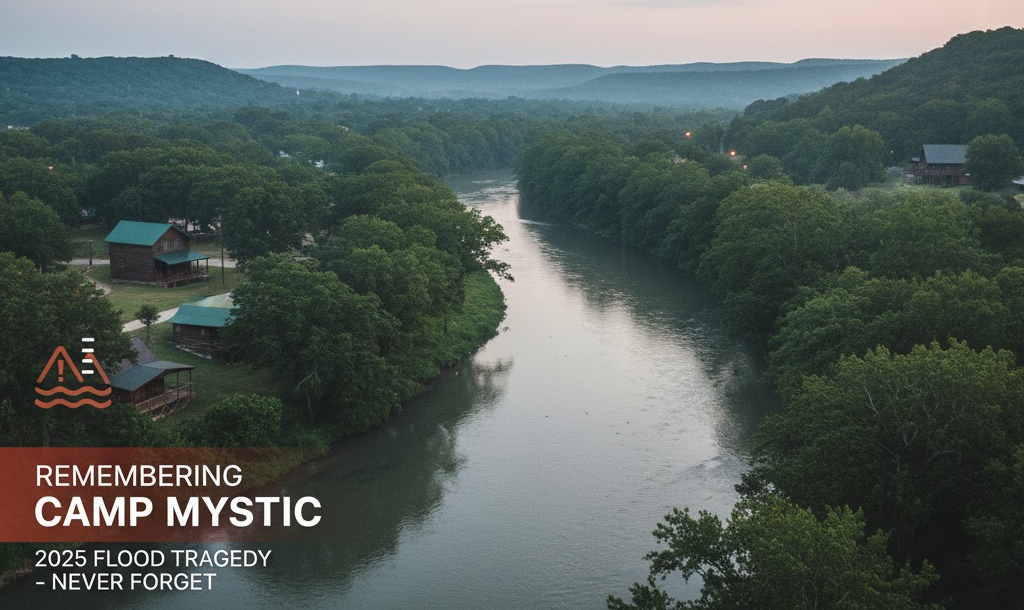
The search for the Camp Mystic missing girls tragically ended with the confirmation of multiple fatalities following the catastrophic flash flooding in the Texas Hill Country in July 2025.1 This article serves as a comprehensive and trustworthy resource detailing the devastating event at Camp Mystic, an all-girls Christian summer camp on the Guadalupe River.2 Our goal is to respectfully explain what happened, honour the lives lost, and provide authoritative information on the timeline and the ongoing call for safety reform.
What Happened at Camp Mystic? The 2025 Flood Disaster
The tragic incident at Camp Mystic in Hunt, Texas, on the Fourth of July weekend in 2025, was not a missing persons mystery in the conventional sense, but a devastating loss of life due to an extreme natural disaster.3 Severe flash flooding from torrential rainfall caused the Guadalupe River to surge with unprecedented speed and force, overwhelming the riverside campground.4
- The Guadalupe River rose by an astonishing 26 feet in approximately 45 minutes in the early morning hours of July 4th.5
- The floodwaters swept through the low-lying cabins, particularly the Bubble Inn dormitory, which housed some of the youngest campers (ages 8–10).6
- The camp director, Richard “Dick” Eastland, along with numerous campers and counselors, died in the flood.7 Eastland reportedly died while attempting to evacuate the girls.8
The Heartbreaking Toll
The event resulted in a confirmed loss of 27 campers and counselors from Camp Mystic, with the names of several young North Texas girls, including Lila Bonner, Hadley Hanna, Eloise Peck, and others, being publicly confirmed among the deceased.9 Rescue efforts involving helicopters, specialized teams, and volunteers were launched immediately.10
A Timeline of Tragedy and Response
Understanding the sequence of events reveals the sudden, overwhelming nature of this disaster, which is characteristic of the Texas Hill Country’s “Flash Flood Alley.”11
Critical Moments Before the Surge
- Flood Warning Received: The camp director received a National Weather Service emergency flash flood warning via phone around 1:14 a.m.12
- Delay in Evacuation: Reports indicate a significant delay—more than an hour—before the decision to begin evacuating the nearly 700 girls was made around 2:30 a.m. By this time, heavy rain had started, and the river was rising rapidly.13
- Communication Issues: Camp policy required staff and campers to hand in their phones, meaning no one else received the direct emergency alerts.14
The Flooding and Aftermath
- Sudden Water Surge: The river’s dramatic rise made a full, safe evacuation impossible. Many cabins were quickly submerged or swept away.15
- Heroic Efforts: Several staff and campers took shelter on higher ground (Senior Hill) or in the tops of cabins.16 The camp director and counselors demonstrated extreme bravery, sacrificing their lives to protect the children.17
- Search and Recovery: The initial list of “missing girls” was high due to the destruction of communication infrastructure, but after weeks of intensive searching, the confirmed number of fatalities tragically rose to 27 campers and counselors.18 The search for a few remaining missing persons continued for a significant period.
The Call for Camp Safety Reform
In the wake of the tragedy, affected families and local officials have fiercely advocated for stronger youth camp safety standards and better warning systems in the Texas Hill Country.19
- Parent Testimony: Parents of the victims, like Cici Williams Steward, whose daughter Cile was still missing weeks later, spoke emotionally at legislative hearings, arguing that “preventable failures” contributed to the loss of life.20
- Regulatory Focus: Lawmakers are now examining the state’s current regulations for summer camps, focusing on:
- Mandatory flood warning systems along high-risk rivers.
- Strict requirements for evacuation protocols and the immediate release of warning information to staff and parents.
- Reviewing building locations, especially for young campers, in known flood hazard areas.
This tragedy underscores the critical need for all organizations operating in high-risk areas to have clear, immediate, and well-rehearsed emergency plans that prioritize life safety above all else.
Honoring the Victims and Moving Forward
The Camp Mystic flood victims—both the young campers and the heroic adults—will not be forgotten.21 Foundations and charities have been established in their names to honor their memory and support causes they cherished.
- Community Support: The local community and the camp’s vast alumni network provided an outpouring of emotional and physical support during the search and recovery efforts.22
- Legacy of Loss: The incident remains a harrowing reminder of the power of nature and the devastating consequences when safety protocols fail in the face of a catastrophic event.23
The full impact of this tragedy extends beyond the loss of life, affecting the emotional well-being of the hundreds of children, families, and staff who were part of the Camp Mystic family.
Conclusion: Lessons from the Hill Country
The story of the missing girls at Camp Mystic is a somber but important one, revealing the critical need for vigilance and preparedness in areas prone to natural disasters. It highlights the devastating consequences of flash flooding in the Texas Hill Country.24 While the incident remains a source of unimaginable grief for the families involved, their ongoing advocacy for camp safety reforms aims to ensure that no other family has to endure such a loss.25 Their voices serve as a powerful catalyst for change in how we protect children at summer camps across the state.
You might be interested in watching a video about the heartfelt testimony from the parents affected by the floods. Parents of Missing Kids From Camp Mystic Testify
Click Here For Informative Blog: James Carville Wife Health






